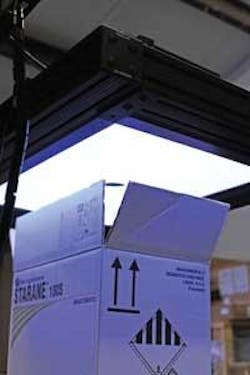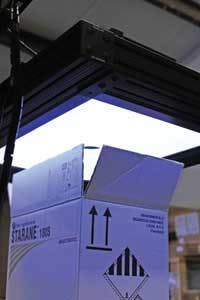IMAGE CAPTURE: Vision system reads pesticide packages
To track the millions of bottles of pesticides it produces per year, a global chemical manufacturer required a system to confirm the traceability of its products after they were packed into cases. After each bottle is filled and sealed, an inkjet printer applies a Data Matrix code on the top of each cap.
Once the open cases are packed, batches of cases move along a conveyor for palletizing at 70 ft/min. To read the Data Matrix codes of these bottles before palletizing, the company called upon Matrix Systems and Solutions (Sanborn, NY, USA; www.matrix-ssi.com) to develop an automated machine-vision system.
Instead of using multiple cameras, a single, monochrome 16-Mpixel GE4900 4872 × 3248-pixel CCD camera from Prosilica (Burnaby, BC, Canada; www.prosilica.com) running at 3 frames/s was selected because of its Gigabit Ethernet output, resolution capabilities, and speed. To capture a wide field of view, a Planar T* 1.4/50 ZF 35-mm lens from Carl Zeiss (Maple Grove, MN, USA; www.zeiss.com) was mounted to the camera.
With a focal length of 51.7 mm, an aperture range of f/1.4–f/16, and a focusing range of 0.45 m to infinity, the lens was selected instead of a telecentric lens to reduce cost. Since more than one type of product needed to be inspected, the application required a relatively large field of view with the dimensions of the largest case being 397 × 320 mm and the smallest being 271 × 205 mm.
In the initial system design, Matrix tested Smart Vision Lights’ (SVL; Muskegon, MI, USA; www.smartvisionlights.com) Adjustable Dark Field Light (DFL). Since the swivel mounts on the DFL allow the lights to be adjusted, it was thought that this would provide a good overhead lighting array. However, initial testing of the DFL showed that the amount of glare or reflection from the white caps on the pesticide bottles failed to provide a useful image.
To overcome this problem, SVL customized its Large Light Panel (LLP) backlight as a large diffuse ringlight, or tent light, by cutting a hole in the center of the light for camera placement (see Fig. 1). After the LLP-2 was laser cut with a 30-mm hole in the center, it was shipped and tested, virtually eliminating the glare issues associated with the DFL (see Fig. 2).
null
As the cases of product move into the inspection station, a CMOS GV-H450 laser sensor from Keyence (Woodcliff Lake, NJ, USA; www.keyence.com) triggers the lighting and camera system to capture an image. After the image is captured, it is transferred via the camera’s Gigabit Ethernet interface to a quad core processor with 8 Gbytes of RAM running Linux.
Custom software is then used to unskew the large image captured by the lens, locate different quantities and orientations of bottles, and to read the Data Matrix code printed on each cap. Where this data can be read, cases are then moved along the production line, sealed, picked by a robot, and placed in cases.
If this data is unreadable, then stack lights strobe and the CPU controls a printer to produce a serialized rejection label that is later placed on the case to prevent untagged bottles from leaving the facility.


